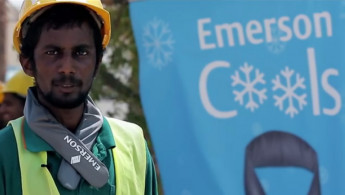Chill-out men: Firm develops 'neck-cooling' wearables for Gulf labourers
Some 1,100 Asian labourers in the UAE will be given neck-cooling wearables, to help keep their body temperatures down during the hot hours of their working day.
The workers of Emerson MEA, an American maker of factory automation equipment, can wear the cooler around their neck to help them perform their day-to-day tasks amid temperatures exceeding 40 degrees Celsius [104 Fahrenheit].
Workers will swap the cooler – which also absorbs sweat from the neck - with a fresh one every hour to reduce their body temperatures.
"Emerson continually strives to make a positive impact on the communities in which they serve. This initiative is a small gesture to help ease conditions for the local workforce and aligns with our mission to enhance human comfort," Dalia Kaki, marketing manager for Emerson MEA, said.
Last year, senior paramedics said that up to 10 labourers collapse from heat exhaustion every day during the summer - despite the UAE's mandatory summer break for for construction workers, which runs from 12:30 until 15:00.
|
|
Regular awareness campaigns are also held across the country, targeting workers on construction sites and road projects to help identify signs of deadly heat exhaustion.
"We teach them basic first-aid measures so they can provide immediate and necessary relief in case a co-worker collapses," said Feroz Babu, a supervisor at the NTPE who has been conducting the workshops told The National.
"This is just to provide support before medical help arrives. We also teach them to watch out for danger signs like muscle cramps, severe headache, drowsiness, nausea and dizziness, because if they are not careful and do not ask for help it could lead to accidents," Babu said.
"We can't stop working in summer so we have to manage work and safety as the humidity levels increase."
Safety leaflets, printed out in five Indian languages, Arabic, Urdu and English, are regularly handed out to workers.
But a recent report by the National Oceanic and Atmospheric Administration found that this year's summer was the hottest in modern times.
The report revealed that above-average warmth across most of the Earth, scorching temperatures were seen in part of the Gulf region, with several locations experiencing temperatures higher than 45 degrees Celsius [113 Fahrenheit] during July.
"The highest maximum temperature during July 2016 was recorded in Mitribah, Kuwait when temperatures soared to 126.5 F on July 22," the report said.


![President Pezeshkian has denounced Israel's attacks on Lebanon [Getty]](/sites/default/files/styles/image_684x385/public/2173482924.jpeg?h=a5f2f23a&itok=q3evVtko)



 Follow the Middle East's top stories in English at The New Arab on Google News
Follow the Middle East's top stories in English at The New Arab on Google News


